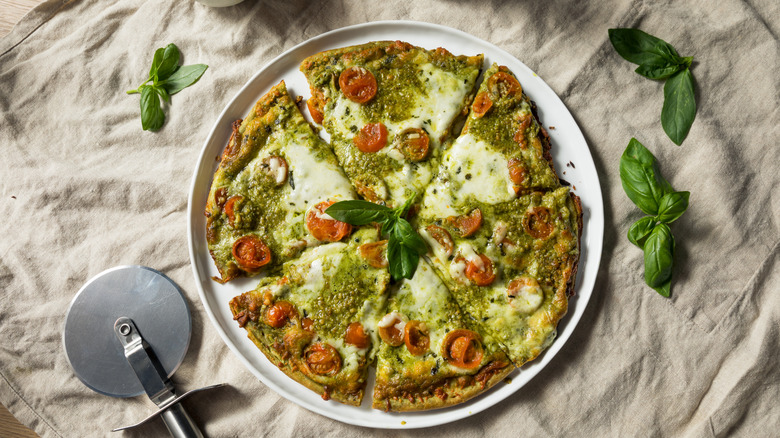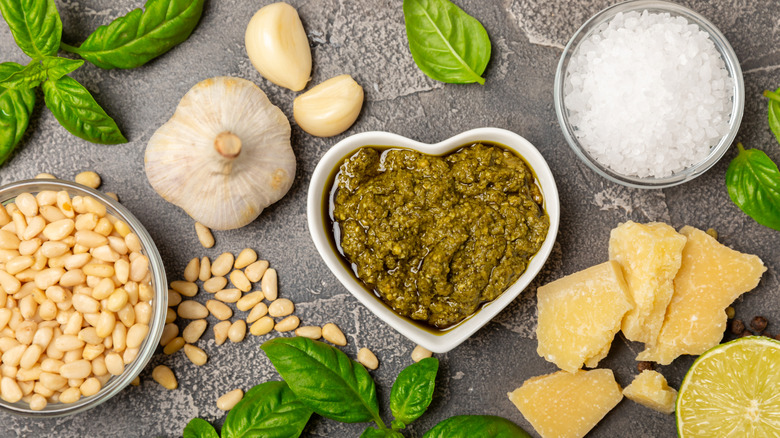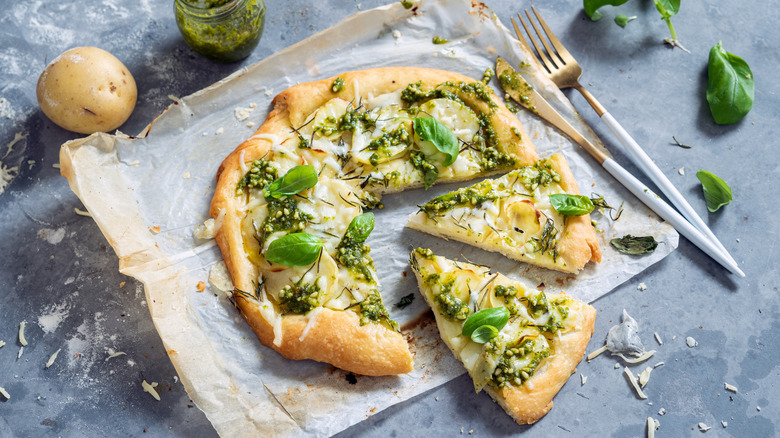If You're Not Using Pesto As A Pizza Sauce, You're Missing Out Big Time
We all have our pizza preferences and have battled it out over thin crust versus thick, square Grandma pies versus traditional round, mozzarella cheese versus ricotta, red sauce versus white — and we haven't even gotten to the toppings. So why risk another argument about if, when, and how to add pesto to your pizza? Because when you taste that blend of herbs, nuts, oil, garlic and cheese, you'll find out the fight is definitely worth it.
There are many different types of pesto, but the type that marries so well with pizza is the original Italian pesto created in the city of Genoa. According to Campionato Mondiale di Pesto Genovese al Mortaio, which holds an annual competition to identify the best pesto maker across the globe, pesto Genovese must be made with basil, pine nuts, Parmesan and Pecorino cheeses, extra-virgin olive oil, garlic and salt and crushed with a mortar and pestle. The result is an aromatic, nutty paste-like sauce, with a strong bite from the garlic and a fresh herbaceous flavor from the basil.
Making your own basil pesto is easy
When making pizza with pesto, you can start by making your own sauce. Although the championship organization specifies that the ingredients be grown or made in the Ligurian region of Italy — where Genoa is located — you can vary your simple pesto recipe using different nuts, herbs and cheese. Although the mortar and pestle is a must in Italy, you can use a food processor or blender while in the comfort of your own home. There are also several flavorful store-bought pesto variations that would be excellent options if you don't have time to make it from scratch.
One thing to consider when making pesto pizza is whether or not to use tomato sauce as well. Using too much of either sauce may cause their flavors to fight each other. If you want to contrast the tanginess and slight sweetness of tomato sauce with the sharp garlicky flavor of pesto, you can use the tomato sauce as your base, top it with the cheese and use a few small spoonfuls of pesto. That will give the pizza bursts of that garlicky flavor. You can also do the reverse — use the pesto as your base sauce and then layer with tomato slices or sprinkle with cherry tomatoes. You can also roast the cherry tomatoes first, which will bring out their sweetness and give them a jammy texture.
Plus up a white pizza
Pesto can also add some zest to the mild flavor of white pizza. White pizza generally refers to any pizza made without tomato sauce. The simplest variation uses three cheeses: Ricotta and Parmesan cheese as well as mozzarella. If you want strong flavor, spread the pesto on the crust first as you would tomato sauce and then layer on the cheeses before baking. The olive oil in the pesto will make the crust crisp up faster, so keep a close eye. Top white pizza with roasted mushrooms for an additional element of earthiness. You can also sprinkle on few fresh basil or spinach leaves to add more brightness.
If you want your pizza to stay rooted in Genoa, make homemade focaccia and use it instead of pizza dough. Focaccia is a flatbread that is similar to pizza dough but is made with a series of indentations to hold the olive oil that is poured on before it is baked and then topped with a coarse salt. Focaccia's history in Genoa dates back to the fourteenth century. While it may not be how the Genoese make pizza, the crustiness of the bread, the crunch of salt against the velvety cheese and pungent pesto would be a delicious way to honor the city's two culinary traditions.


